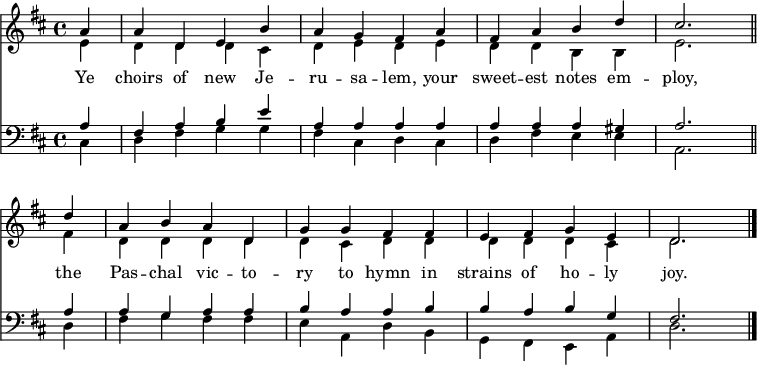Musical settings
"Ye Choirs of New Jerusalem" has been described as the "only medieval resurrection hymn still widely sung", but it owes more of its enduring popularity to the vigour of Campbell's translation and to the hymn's cheerful tune than the original text. [7] The original chant melody, in the 3rd mode, [4] [14] is not associated with the modern text, although it appears as a setting for Neale's translation in the 1906 English Hymnal, [15] and for one of Neale's other texts in the 1916 Hymnal of the American Episcopal Church. [16]
The hymn is most commonly set to [17] and was made famous by [18] the tune "St Fulbert" by Henry John Gauntlett, which first appeared in The Church Hymn and Tune Book (London, 1852). There it was used for the hymn "Now Christ, our Passover, is slain" and was known as "St Leofred". The editors of Hymns Ancient and Modern set Campbell's altered text to it and renamed it according to the original Latin author, adding a concluding "Alleluia! Amen". [6] A setting appears in the 1987 collection 100 Carols for Choirs , with the harmonisation from the English Hymnal (transcribed below) [13] and a last verse descant by David Willcocks. [19] An alternative tune is "Lyngham", a fuguing tune by Englishman Thomas Jarman, [17] whose "astonishing and invigorating" choral-style polyphony echoes the first stanza instruction for "choirs" to employ their "sweetest notes". [10]

Settings as an anthem
A notable setting of the hymn to music is in the form of an anthem for Eastertide by Charles Villiers Stanford. Completed in December 1910 and published as the composer's Op. 123 by Stainer & Bell the next year, this setting of all six stanzas of the hymn uses completely new musical material, [18] with two main musical ideas, the first in major mode in triple metre ('Ye choirs of New Jerusalem') and the second in minor quadruple metre ('Devouring depths of hell their prey'). The piece begins in G major and modulates through various keys, alternating between the two main themes before concluding in a fanfare-like fashion on "Alleluia! Amen". [20]
Other settings in the form of an anthem include works by Ivor R. Davies, Archie Fairbairn Barnes and Hugh Blair. [21] [22] [23] The hymn has also been set, to a new melody, by contemporary composer Kile Smith. [24]